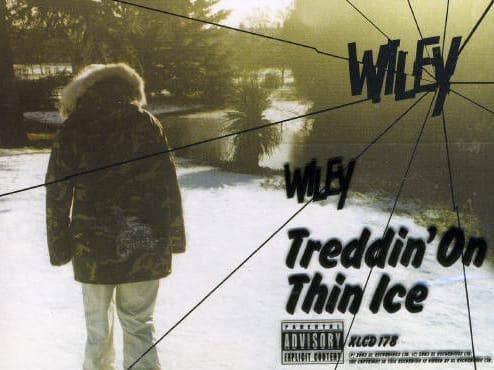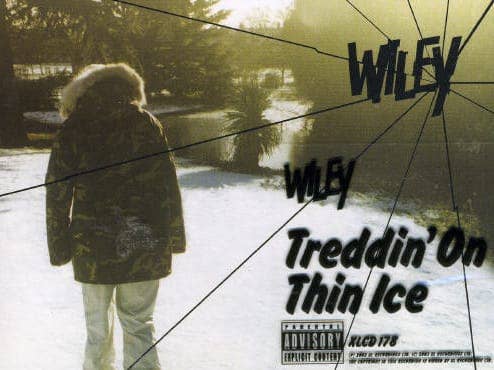
Pressure will tell you a lot about a patch of ice: where it's strongest, where it's weakest, and where it'll crack. Apply too much, and the whole thing shatters, but apply a little and fault lines appear, making it visible. You may not notice the ice at all until you apply pressure... or slip and crack your neck.
Treddin' On Thin Ice, Wiley's seminal debut album, was made under pressure.
On April 26, 2004, the 25-year-old not-yet-godfather of grime had to deliver a full-length project that would satisfy his underground fanbase, his label's expectations, and a music press eager to anoint grime music as England's answer to millennial hip-hop. Instead, he dropped a set that divided fans, got him dropped from XL Recordings, and confounded critics. Neither cracking under pressure nor bending to its whims, Treddin' On Thin Ice launched a career's worth of left turns through which the emcee doggedly refused to conform to anyone's demands or expectations. It was also frequently brilliant, combining aspirational and confrontational messages, humour and seriousness, and street experience with hope of redemption.
Most pressingly, the album had to live up to Dizzee's Rascal's Boy In Da Corner. Wiley and Dizzee's careers would soon diverge wildly, but back then, they were still grime's yin and yang, united by a label and manager but divided by beef and stylistic impulses. Tellingly, every major review of Treddin'... compared it to Boy In Da Corner with Wiley coming up short critically and commercially. Dizzee's LP may have been punishingly bleak, but it was cohesive and serious in the way that music critics lapped up, earning it 2003's Mercury Prize and praise for its emotional depiction of East London life.
IT'S A DEBUT THAT GAVE THE MC ROOM TO GROW.
In contrast, Treddin'... leaned heavily on rap and dancehall's commercially-coded shiny textures only to twist them into bizarre, alien shapes, tricking listeners into dancing to deeply futuristic dance music by virtue of its superficial similarities to commercial hits. Rhyme wise, Wiley's lyrics covered the same bleak tower-block upbringing as Dizzee's, but without the straight-faced seriousness: pleas begging youngers to stop the violence bounced off non-sequiturs and bizarre pie-related hooks. As a result, Wiley was somehow both more pop leaning and harder to grasp than Dizzee, and neither rock critics nor the record-buying public knew what to make of it.
The album didn't sell as well as expected, and Wiley would swerve towards commercial compromise with Roll Deep before course correcting with a series of mixtapes for Boy Better Know, bouncing back and forth between the mainstream and underground. The album expressed uncut black angst, but also packaged it in a way Radiohead fans could understand—a feat not even Dizzee himself would be able to repeat.
So while Dizzee and Kano's debut albums are universally lauded, Wiley's remains a subject of heated debate. Is it underrated? Was it a noble failure? Why didn't he include some of those classic white-label beats? And the hook to "Pies"—why would anyone think that was a good idea?
Yet, despite its choppy genesis, Treddin'... is a fantastic grime record. For one thing, Wiley's never made another album leaning so heavily on his classic Eski-beat style, making it a joy to listen to. With classic white label riddims like "Eskimo" and "Ice Rink" reduced to interludes, he spends the record finding ways to twist his frosty squarewaves and pentatonic bass plunks to new tempos, from the high-speed bounce of "Reasons" to "Got Somebody"'s bashment flex. He even beats New York street legends (and major grime influence) Dipset at their own game on "Special Girl", roping in Kano to deliver the best duet Cam and Juelz never made, all over an SWV sample. And when Wiley did stick to straight grime, he coloured it with the kind of off-kilter, tongue-in-cheek humour that's since been his trademark, sounding more neurotic than psychotic on tracks like "Pick U R Self Up" and "Going Mad".
IT WAS FREQUENTLY BRILLIANT, COMBINING ASPIRATIONAL AND CONFRONTATIONAL MESSAGES, HUMOUR AND SERIOUSNESS, AND STREET EXPERIENCE WITH HOPE OF REDEMPTION.
Then there's "Wot Do U Call It?", perhaps the best song ever written about music scene politics. Definitively cleaving grime from garage over a bizarre mixture of digital tuba and caustic bass, it's the closest Wiley's ever gotten to fully explaining his unique mixture of pop aspiration and underground allegiance and proof of concept for the hardcore continuum. The crown jewel of an album that demands to be taken on its own terms, it still sounds like the future, over a decade later. Treddin' On Thin Ice isn't a flawless record but it's a deeply human and compulsively listenable one, and just as importantly, it's a debut that gave the MC room to grow.
Since 2004, Wiley's dropped street classics for Boy Better Know, pop crossovers for Asylum and Warner and underground bubblers for Big Dada, but each one of those records spawned from ideas first conceived on this ice-dripping album. Like its creator, it's not a record that's easy to love, but for those of us that do, it's a reminder that pressure makes diamonds and that messiness is no impediment to classic status.

